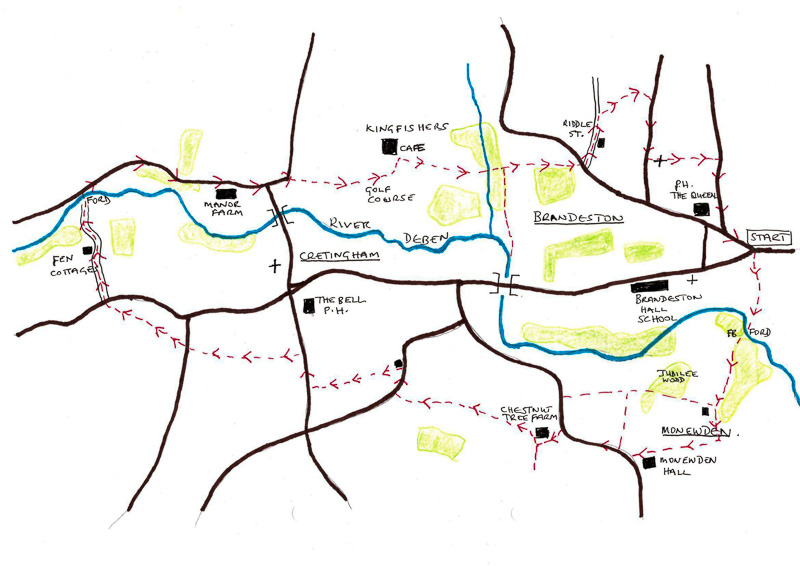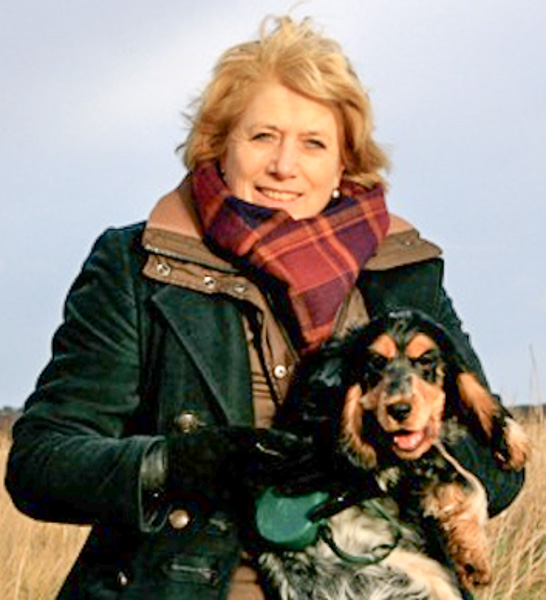By Sue Ryder-Richardson
Map: OS Explorer 212 TM 251604. Start: Bridleway on Kettleburgh Road at east end of Brandeston village. Distance approx 6.5 miles.
The Upper Deben Valley in August 2022 is biscuit dry. The small rills, the source of this beautiful river above Debenham, are dried, fords and water splashes empty, yet further downstream in the heart of the farming countryside of Brandeston*, Cretingham, Monewden, as if by magic, the Deben has gathered some water, and flows gently through its green, tree lined valley.
Fortunately, this is a familiar walk and so the golden stubble fields, the deep cracks in the clay uplands, and profound woodland shadows, I know to be only part of the story. For today, wildflowers are brittle seed pods, and the hedgerows bear the early precursors to autumn; swelling blackberries, reddening hips and haws, and damsons ready for the picking.
But start this walk in late Spring, along the bridleway in Brandeston, and the path will be filled with cow parsley and briar rose as it descends to the ford. Pause on the footbridge over the Deben and watch the water plants wave in the stream, dragonflies dart, and birds that dip and dive for water. Here there is a chiaroscuro of light that shifts through the willows and the poplar plantation. It is a delight in all seasons.
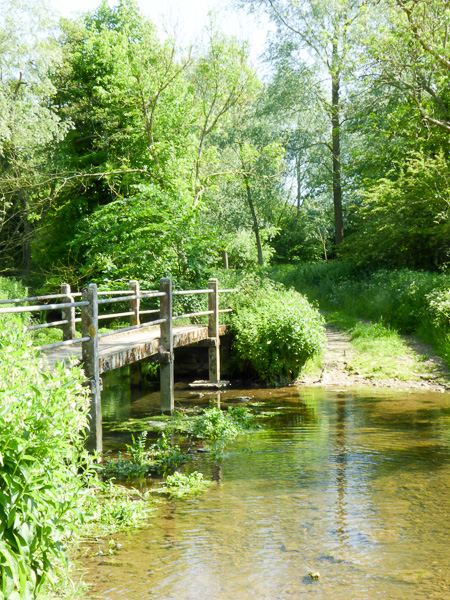 Over the bridge, keep on up the hill beside the wood. It is here in early summer you will find the gentle bonnets of wood sorrel and anemones. On reaching the cottage, either turn right along the hedgerow and skirt Jubilee wood to reach a lane where you turn left. Or, continue ahead and take the first right turn up the bridleway towards Monewden Hall. This is first of many beautiful properties along this route. At the lane turn right, then left at Chestnut Tree Farm. Keep ahead here and pass by a wood on your right.
Over the bridge, keep on up the hill beside the wood. It is here in early summer you will find the gentle bonnets of wood sorrel and anemones. On reaching the cottage, either turn right along the hedgerow and skirt Jubilee wood to reach a lane where you turn left. Or, continue ahead and take the first right turn up the bridleway towards Monewden Hall. This is first of many beautiful properties along this route. At the lane turn right, then left at Chestnut Tree Farm. Keep ahead here and pass by a wood on your right.
At the lane turn right and very shortly left through a well-hidden path in a hedge, and at the next lane repeat, a right and left onto another well disguised footpath. All these paths cross wide farming uplands with panoramic views over a landscape, and on down to the Deben Valley. If only the fields had not had hedges removed, the land would feel as old as the houses that nestle within it, scattered as they are over the undulating hills.
Cross over the next lane, heading down towards a wood and a road. Here, there is a choice. Keep ahead onto the bridleway past Fen Cottages, but only if there had not been rain of late, for the footbridge at the end of the path is closed (the notice from 2014 speaks of a temporary closure. It is now hard to see the footbridge through the brambles), and the only alternative is to walk over the ford, easy if dry, not so if wet.
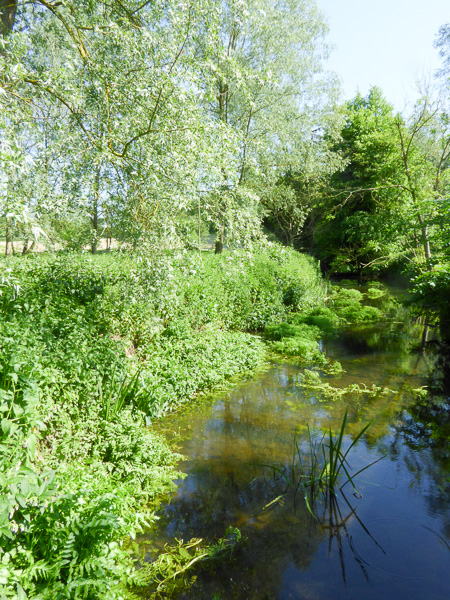 Either way on reaching the lanes turn right towards Cretingham. If taking the first right, along a quiet road, turn left in the village to pass the Cretingham Bell, an excellent place for refreshment, and then on past the Church. This is well worth a visit with its 13th Century origins, dark draft excluding box pews, and interesting artefacts.
Either way on reaching the lanes turn right towards Cretingham. If taking the first right, along a quiet road, turn left in the village to pass the Cretingham Bell, an excellent place for refreshment, and then on past the Church. This is well worth a visit with its 13th Century origins, dark draft excluding box pews, and interesting artefacts.
If you have crossed the ford and turned right, bear left on reaching the road from Cretingham Village, and very shortly right down a track signed Kingfishers* and Cretingham Golf Course. Kingfishers has been recently bought by Matthew and Claire Thacker, who are in the process of re-wilding this Country Park, putting in 1000 new trees, and creating Nature Trails, with the assistance of some of Suffolk’s ecological specialists. There are refreshments here in a lovely indoor-outdoor cafe.
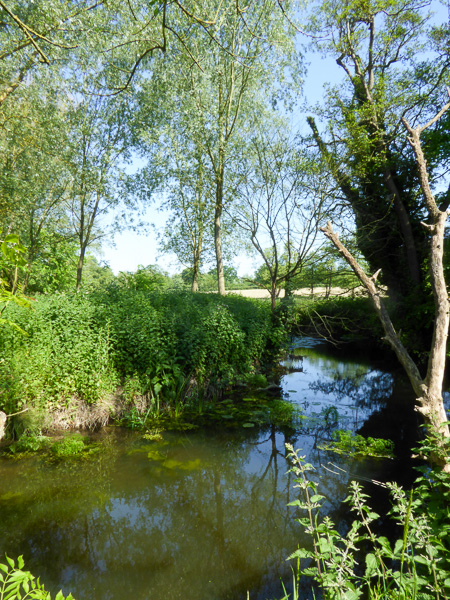 Follow the footpath signs through the Park, on through a glade, and water meadows, to cross a tributary of the Deben. It is possible to shorten the walk here by turning right along the riverbank and following the path through woods to meet the Cretingham-Brandeston Road. Here a left turn will take you back into the village.
Follow the footpath signs through the Park, on through a glade, and water meadows, to cross a tributary of the Deben. It is possible to shorten the walk here by turning right along the riverbank and following the path through woods to meet the Cretingham-Brandeston Road. Here a left turn will take you back into the village.
Alternatively, keep ahead on the path from the bridge, and climb a steep incline. Turn right on the lane and immediately left onto a track called Riddle Street. Pass Grove Farm and before the next cottage, take the bridleway right. On reaching the lane, turn right and then take the footpath left at the small chapel, through the churchyard to a gap in the hedge. Cross the field towards a house, walk through a farm drive and turn right into Mutton Lane, to return to Brandeston village. The Queen Public House is on your left, another good place to stop, otherwise turn left and then right to reach the start of the walk.
Sue Ryder-Richardson
Born in Suffolk, I have a great love for a county that I have explored on foot for as long as I can remember. Slow travel lets me enjoy the landscape; savour its history, flora and fauna. After many years of the London commute, it is such a pleasure to be able to write walks for publication, as well other pieces. Currently I’m interested in the future development of the ‘Slow Ways’ initiative. https://slowways.uk/
Notes:
* Brandeston is a flourishing village, with the historic Brandeston Hall now home to Framlingham Prep School. It is as much a sought village in current times as it appears to have been throughout its history.
Brandeston is referenced in the Domesday Book although its origins are significantly earlier. The ford here was a major crossing point of the Deben, and the early route possibly subject to a toll.
The village escaped the plague in the C14th, although many villages to the south were wiped out. In the same century the Black Prince built his Hunting Lodge here, and these same lands were also hunted by the Witchfinder General in the C17th, where he obviously found more than just the ‘witch’ John Lowes, the vicar, who was hanged for his dealings with the devil.
Brandeston was a major stopping place on the C18th smuggling route from Syzewell Gap to Hadleigh. It was at some time home of the infamous romantic smuggling heroine, Margaret Catchpole. Legend has it that contraband was hidden in the pond inside her garden gate.
The poet George Crabbe, also lived in Brandeston. His poem ‘The Borough’, was the inspiration for perhaps Benjamin Britten’s most famous opera, ‘Peter Grimes’.
* Kingfishers is a landscape of rare ecological value within Suffolk. The area has diverse and special land, as well as significant water habitats. This includes mature woodland alongside the public footpath. The woodland is being managed to allow biodiversity to flourish; timber is being left to make beetle banks, and the woodland flora flourishes under the high canopies. Walkers will also pass by meadows where Claire and Matthew Thacker are encouraging ecological restoration, allowing natural grasses, wildflowers and valuable scrub to return.

